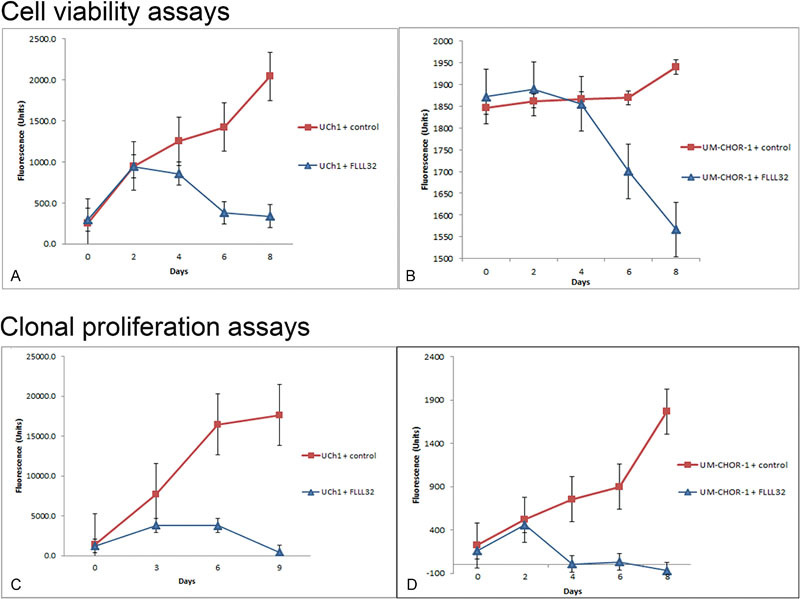Fig. 1.

FLLL32 inhibits cellular proliferation and exhibits cytotoxicity. (A) Resazurin cell viability assays were performed on the UCh1 cell line in vitro. Cells were plated at a concentration of 2,500 cells per well, then treated with 5 µM FLLL32 or equal volume of 0.1% DMSO vehicle as a control. Cell viability in FLLL32-treated cells was dramatically reduced, relative to the normal growth pattern exhibited by control cells. Growth arrest was witnessed after approximately 2 days, with a significantly diminished population of viable cells following treatment with FLLL32 (p < 0.01). (B) Resazurin cell viability assays were performed on the UM-CHOR-1 cell line in vitro. Cell viability in FLLL32-treated cells was significantly reduced, relative to the normal growth pattern exhibited by control cells. Growth arrest was witnessed after approximately 2 days, with a significantly diminished population of viable cells following treatment with FLLL32 (p < 0.05). (C) Clonal proliferation assays were performed to evaluate the cytotoxicity of FLLL32 on the UCh1 cell line in vitro. Cells were plated at a concentration of 10,000 cells per well and allowed to grow for 72 days. Cells were then treated with 5 µM FLLL32 or equal volume 0.1% DMSO vehicle as a control. Cytotoxicity was demonstrated after 3 days in FLLL32-treated cells. Complete arrest of cell proliferation was witnessed in UCh1 cells with a decline of cell numbers to 2.6% in the treated cells by day 9 (p < 0.01). (D) Clonal proliferation assays were performed to evaluate the cytotoxicity of FLLL32 on the UM-CHOR-1 cell line in vitro. Though not immediate, cytotoxicity was demonstrated after 2 days in FLLL32-treated cells. Within 24 hours of initiating treatment with FLLL32 (day 4), no viable cells could be detected. This effect was sustained for the remainder of the assay period and was statistically significant when compared with untreated controls (p < 0.01). DMSO, dimethyl sulfoxide.
